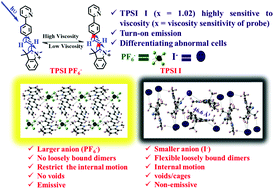Engineering a light-driven cyanine based molecular rotor to enhance the sensitivity towards a viscous medium†
Abstract
This article describes the enhanced sensitivity to a viscous medium by a molecular rotor based fluorophore (RBF), TPSI I. The TPSI I molecule is designed in such a way that it consists of a rotor and a fluorophore with a π-rich bridge between them. TPSI I is a light-responsive material in solution as well as in the solid state. The structural design of the molecule allows flexible rotation and photo-induced cis–trans isomerization both in the solid state as well as in solution. These combined attributes of TPSI I are responsible for the ultrasensitive viscosity response of the new material, which was verified through the Förster–Hoffmann equation. According to this equation, the derived ‘x’ value is 1.02 (x is related to the sensitivity) which is the highest among the contemporary reports for RBFs. The facts were evidenced both by experimental as well as theoretical data. The ultrasensitivity towards viscosity was further analyzed in in vitro studies by detecting the subtle changes in the alteration of intracellular viscosity in normal and cancerous cells. An alteration of intracellular viscosity in cells treated with viscosity modulators was also confirmed using a previously well-established viscosity measurement technique, dynamic measurement through the piezoelectric patch. Our research offers a detailed mechanism to improve viscosity sensors and an efficient probe for detecting minute changes in intracellular viscosity.



 Please wait while we load your content...
Please wait while we load your content...